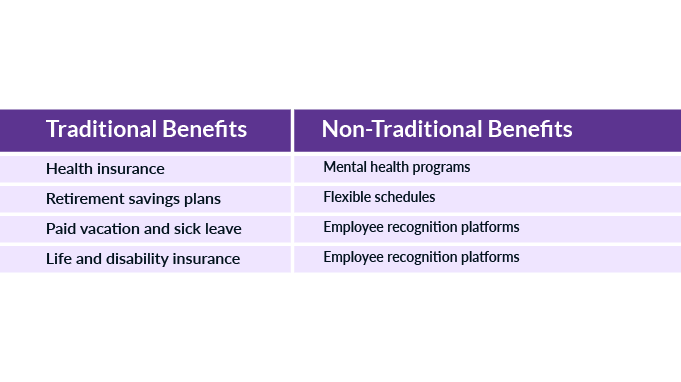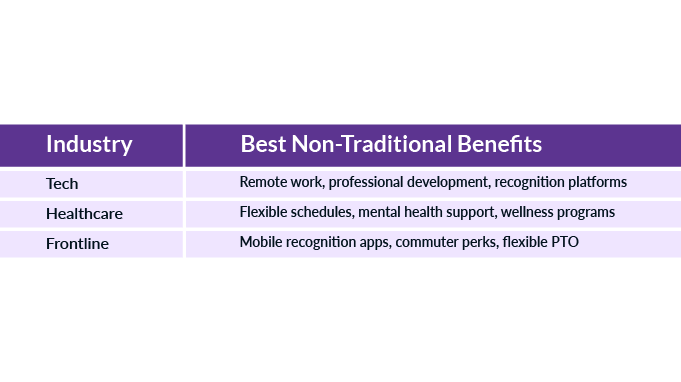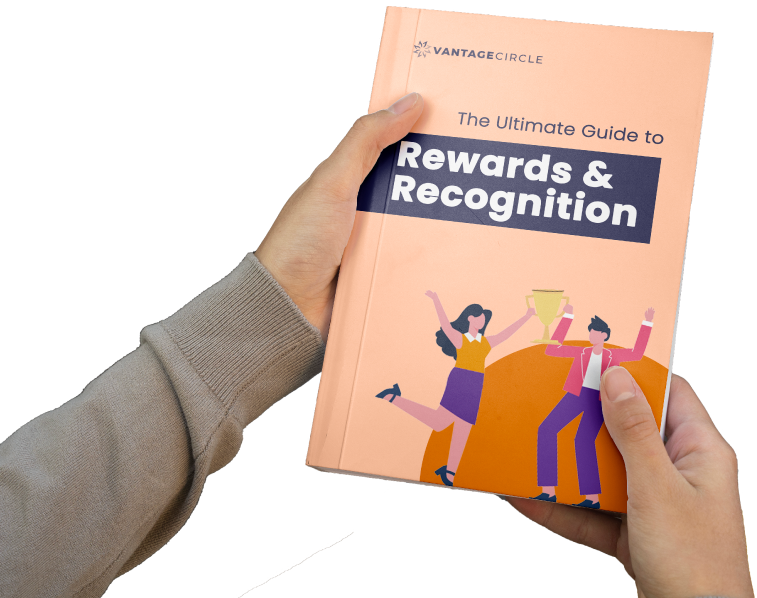Non-Traditional Employee Benefits: Examples, Advantages, Trends & Best Practices

A Global Employee Recognition and Wellness Platform
Why Standard Benefits Aren’t Enough
A friend of mine just turned down a job with better pay. Why? His current company gives him "Recharge Fridays" twice a month – no meetings and flexible hours. "The extra money wasn't worth giving up those Fridays," he told me. "They keep me sane."
This is why smart companies are completely rethinking employee benefits. The standard packages just don't work anymore. Today's employees want benefits that actually fit their real lives.
The pandemic changed our relationship with work. Now, companies that attract the best talent aren't just offering bigger paychecks, they're offering a better work experience.
Health insurance and retirement plans are just the baseline now. Workers want employers who understand they have families, personal goals, mental health needs, and interests outside of work. They're looking for companies that support them as whole people, not just as employees.
When a company shows it truly understands what makes your life better, wouldn't you be more likely to stay?
This isn’t a workplace of the future — it’s happening today in companies that understand one simple truth: employees want more than a paycheck and health insurance.
61% of workers say they’d leave their job for better benefits elsewhere (MetLife). And those who feel genuinely cared for are 2.7x more likely to be engaged and committed to their company (Gallup).
If you want to attract, retain, and energize your workforce, it’s time to go beyond the basics. In this blog, we’ll show you how non-traditional benefits, from wellness perks to real-time recognition platforms, are transforming workplaces and helping companies win the talent game.
Defining Next-Generation Employee Benefits
Non-traditional employee benefits are perks that go beyond the usual healthcare and retirement plans. They’re designed to enhance an employee’s entire life experience — supporting their financial health, emotional well-being, career growth, and even their hobbies and family commitments.
Think: mental health programs, student loan repayment help, flexible work policies, and digital recognition tools that foster daily appreciation.
The big picture? These benefits help companies create workplaces where employees want to stay and grow, leading to higher retention, better morale, and stronger performance.
Traditional vs. Non-Traditional Benefits: What’s the Difference?
Let’s keep this simple:

Traditional benefits are the basics, essential but expected.
Non-traditional benefits are the extras that make employees feel genuinely appreciated and motivated to stick around.
And companies that get this right are the ones winning the battle for talent today.
Real-World Examples of Non-Traditional Employee Benefits
Let’s look at the different categories of non-traditional benefits and what they include.
1. Wellness Benefits
I feel that health goes beyond physical fitness. Wellness benefits that cover mental, emotional, and lifestyle well-being.
- Mental health support: Therapy sessions, counseling, mental health days, mindfulness apps.
- Physical wellness perks: Fitness stipends, on-site gyms, nutrition consultations, and even sleep pods.
- Holistic programs: Company challenges and wellness platforms that encourage healthy habits.
When your team feels good, they perform at their best and are more likely to stick with you.
2. Financial Well-Being Benefits
I’ve seen firsthand how money stress can weigh people down, it doesn’t just stay at home, it shows up at work too. That’s why I’m a big believer in offering financial support where possible. Even small steps can ease the pressure and help people focus, breathe, and perform at their best.
- Financial planning assistance: Help with budgeting, debt repayment, and saving for big goals.
- Student loan & tuition help: Easing the burden of education costs is a huge pain point for younger workers.
- Lifestyle Spending Accounts (LSAs): Flexible funds employees can use for wellness, family care, or even travel.
It’s about helping employees feel more secure and less distracted by financial worries.
3. Work-Life Balance Benefits
I personally prefer flexibility. Not just in where I work, but in how I have to balance work with life.
- Remote work & flexible hours: Let them choose when and where they work.
- Unlimited Paid Time Off (PTO): A trust-based approach to time off.
- Sabbatical leave: Longer breaks for personal growth or recharge.
- Childcare support: On-site childcare, subsidies, or reimbursements to help working parents.
Companies that prioritize balance create environments where employees thrive — and stay longer.
4. Professional Growth Benefits
Investing in your team’s growth pays off in loyalty and better performance.
- Professional development budgets: Funds for courses, workshops, certifications.
- Continuing education support: Tuition reimbursement for degrees and structured learning.
- Career consulting: Help employees map out their professional paths.
When people see a future with your company, they’re more committed today.
5. Employee Recognition Platforms
It's been my personal experience that a well-timed and well-placed appreciation can light up a room, lift spirits, and spark real motivation. Yet, it’s so easy to overlook in the day-to-day rush. That’s why I love recognition platforms. They make it simple to celebrate both the big wins and the quiet, consistent efforts that keep everything moving. And honestly, those moments of appreciation, seeing your efforts being acknowledged on your feed? They matter more than we realize.
- Digital tools: Platforms like Vantage Recognition help teams share real-time kudos and reward contributions.
- Integration with daily tools: Recognition right inside Slack, Teams, or email.
- Points and rewards: Employees earn points they can redeem for gifts, experiences, or donations.
Companies with strong recognition cultures see 31% lower turnover and much higher engagement (Gallup).
6. Unique Perks That Stand Out
If you want to make an impression, offer something unexpected. I’ve found that the perks that are customized to your employees' needs are often the ones people remember most. It shows you’re listening, you care, and you’re not afraid to go the extra mile.
- Pet-friendly offices: Because pets are family too.
- Commuter benefits: Help offset travel costs.
- Cultural experience funds: Support employees in pursuing arts, travel, and hobbies.
These special touches help your company stand out in a competitive job market.
7. Perks for Remote Employees
I’ve worked remotely myself, and I know how isolating it can feel at times. That’s why I believe it’s so important to make sure remote employees feel just as connected and valued as anyone in the office. A little effort goes a long way, and it truly makes a difference.
- Home office stipends: Help them create a productive space.
- Virtual wellness sessions: Yoga, meditation, or fitness classes online.
- Digital recognition: Keep appreciation flowing with tools that work remotely.
Why Companies Are Moving Toward Non-Traditional Benefits
There’s a reason this shift is happening everywhere:
- Employees expect more: Millennials and Gen Z want jobs that support their whole life, not just a paycheck.
- Attracting talent is tough: Benefits are now a key factor in where people choose to work.
- Morale and productivity go up: Happy, supported employees perform better.
- Technology simplifies everything: Platforms like Vantage Circle help streamline various aspects, from wellness perks to recognition, all in one place.
- Bottom line: modern benefits are no longer optional. They’re a must if you want to win in today’s talent market.
The Power of Employee Recognition
Let’s take a closer look at one benefit that has a significant impact at relatively low cost: recognition.
- Companies with strong recognition see 31% less turnover.
- Employees are 2.7x more likely to be engaged when they feel appreciated.
- Recognition boosts morale, job satisfaction, and loyalty.
A simple "thank you" or public acknowledgment makes people feel seen, and that feeling translates directly into retention and performance.
Platforms like Vantage Recognition make this easy, fun, and scalable across teams of any size.
Pros & Cons of Non-Traditional Benefits
Advantages
- Stronger employer brand: Stand out in a crowded market.
- Lower turnover: Retain your best people.
- Higher engagement: Motivated employees do better work.
Challenges
- Cost: Some perks require careful budgeting.
- Complexity: Managing multiple programs can take effort.
- Fairness: Ensure all employees have equal access and understanding.
The trick is to tailor your benefits to what your people truly need and what makes sense for your business.
Top Trends in Non-Traditional Benefits
Personalized, Flexible Perks
Customizable benefits, like LSAs, are replacing one-size-fits-all packages. Employees want choices that fit their lifestyle.
Bigger Focus on Mental Health
Companies are investing more in therapy access, mental health days, and destigmatizing conversations around well-being.
Seamless Tech Integration
Recognition platforms now integrate with Slack, Teams, and HR tools — making appreciation a natural part of daily workflows.
Best Practices: How to Roll Out Non-Traditional Benefits
If you’re ready to start, follow these steps:
- Ask employees what they want — surveys and feedback sessions are key.
- Start small — pilot new perks before rolling them out company-wide.
- Communicate clearly — make sure everyone knows what’s available and how to use it.
- Ensure fairness — benefits should be inclusive and accessible to all.
- Measure success — track engagement, usage, and retention metrics.
Matching Benefits to Your Industry
Different industries have different needs. Here’s what works best:

Tailoring your perks to your workforce’s realities is the secret to making them effective.
Time to Go Beyond the Basics
Let’s face it, today’s workforce expects more, and rightfully so. Companies that truly listen and go beyond the basics with non-traditional benefits? They’re the ones people want to work for and stay with.
When you offer things like flexible schedules, financial support, opportunities for growth, and real-time recognition, it sends a clear message: “we see you”, “we value you”, and “we’ve got your back”. That kind of support sticks.
And if you’re trying to bring all of that together in a way that’s seamless and meaningful, platforms like Vantage Circle can help make it easier and more impactful.
At the end of the day, it’s about building a workplace that feels good to be a part of where people can grow, stay, and genuinely thrive.

















